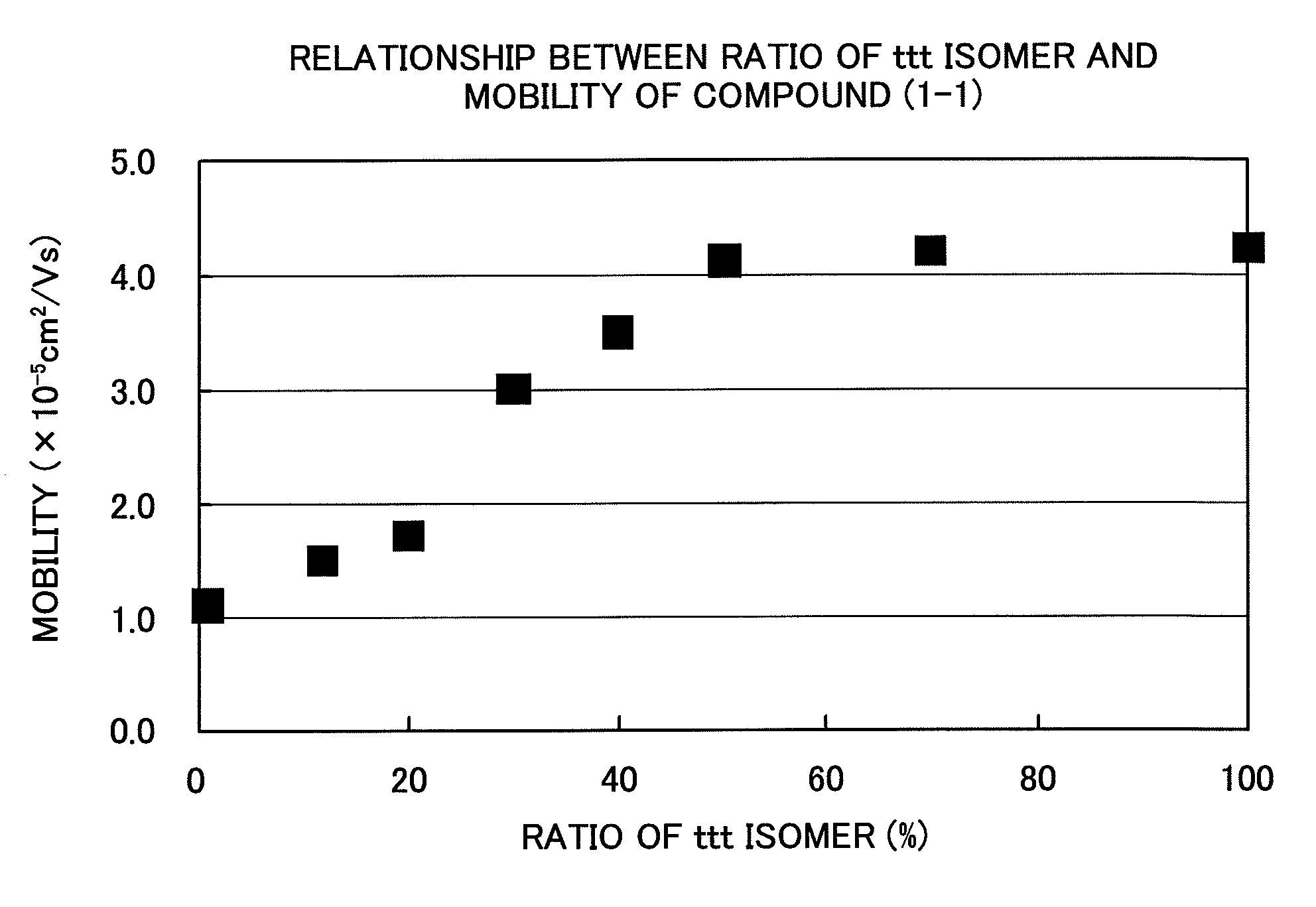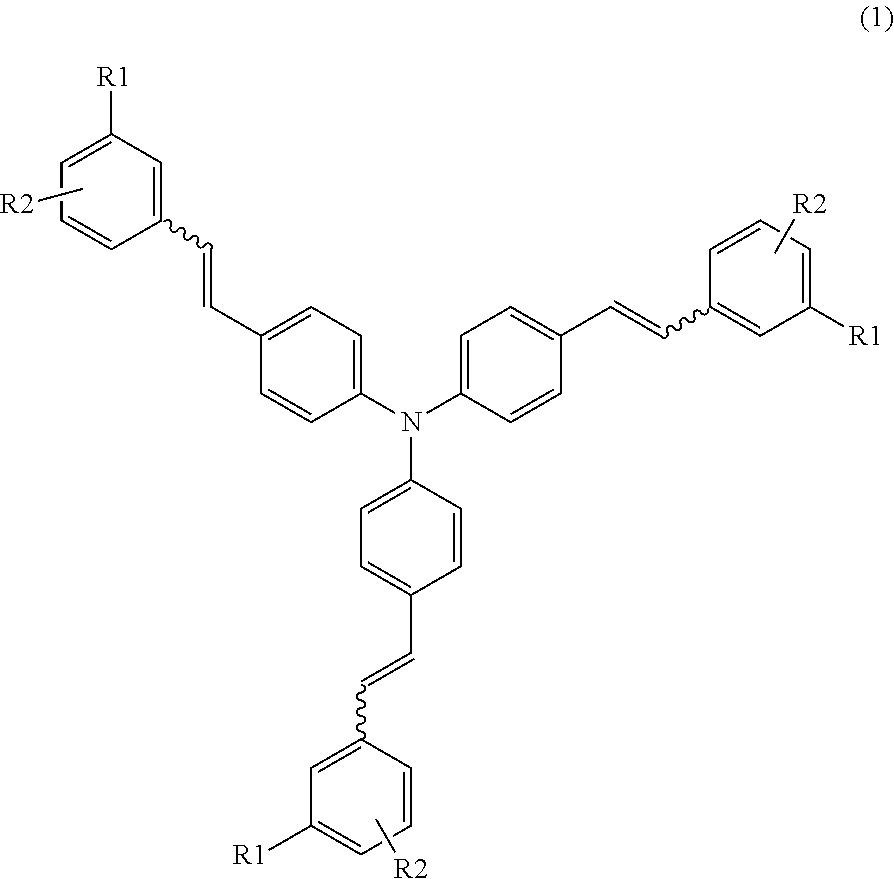Electrophotographic photoreceptor
a photoreceptor and electrophotography technology, applied in the field of electrophotography photoreceptors, can solve the problems of insufficient solubilities of tris(styrylphenyl)amine-based compounds in polymer binders and organic solvents, and the insufficient carrier mobilities of electrophotographic photoreceptors using these films, etc., to achieve high sensitivity, good mechanical properties, and high mobility
- Summary
- Abstract
- Description
- Claims
- Application Information
AI Technical Summary
Benefits of technology
Problems solved by technology
Method used
Image
Examples
synthesis example 1
Synthesis of Compound (1-1)
[0065]To 29.0 g (207 mmol) of α-chloro-m-xylene, 37.8 g (228 mmol) of triethyl phosphite was added. The mixture was heated under reflux for 10 hours to obtain 52.3 g of a colorless liquid. Then, 47.3 g (187 mmol) of the colorless liquid was dissolved in 300 ml of N,N,-dimethylformamide (DMF), and 27.6 g (197 mmol) of p-chlorobenzaldehyde was added thereto. Under a nitrogen atmosphere, 23.1 g (206 mmol) of potassium-tert-butoxide was added thereto, followed by an additional stirring for 2 hours. The resulting mixture was neutralized with water and hydrochloric acid, and extracted with toluene. The toluene layer was washed with water, then concentrated, and subjected to a recrystallization operation. As a result, 36.6 g of a stilbene derivative was obtained. The yield was 85.6%.
[0066]Under a nitrogen atmosphere, 34.5 g (150 mmol) of the obtained stilbene derivative, 13.5 g (141 mmol) of sodium tert-butoxide, 1.1 g (47 mmol) of lithium amide, 172 mg (0.47 mmo...
synthesis example 2
Synthesis of Compound (1-2)
[0070]To 54.8 g (340 mmol) of p-chlorobenzyl chloride, 54.9 g (330 mmol) of triethyl phosphite was added, and the mixture was heated under reflux for 6 hours, followed by prification by distillation. As a result, 81.5 g of a colorless liquid was obtained. The yield was 94.0%. Into 300 ml of N,N,-dimethylformamide (DMF), 56.3 g (215 mmol) of the colorless liquid was dissolved, and further 30.7 g (226 mmol) of m-anisaldehyde was added thereto. Under a nitrogen atmosphere, 26.5 g (237 mmol) of potassium-tert-butoxide was added thereto, and the mixture was further stirred for 2 hours. The resultant mixture was neutralized with water and hydrochloric acid, and extracted with toluene. The toluene layer was washed with water, then concentrated, and subjected to a recrystallization operation. As a result, 43.2 g of a stilbene derivative was obtained. The yield was 82.3%.
[0071]Under a nitrogen atmosphere, 41.5 g (170 mmol) of the obtained stilbene derivative, 15.3 ...
example 1
[0095]Into 85 parts by weight of tetrahydrofuran, 15 parts by weight of “Panlite TS-2020” (manufactured by Teijin Chemicals Ltd.) and 15 parts by weight of Compound (1-1) were dissolved by mixing. The solution was applied by using a doctor blade onto a sheet in which aluminum was vapor deposited on a polyethylene phthalate (PET) film, followed by drying at 80° C. for 3 hours. Thus, a charge transport layer was formed (thickness: 18 μm). Further, a translucent gold electrode was vapor deposited on this charge transport layer, and the charge carrier mobility was measured. For the measurement of the carrier mobility, a nitrogen gas laser having a pulse half width of 0.9 sec and a wavelength of 337 nm was used as a light source, and the time-of-flight method (Toshiaki Tanaka, Yasuhiro Yamaguchi and Masaaki Yokoyama, Denshi Shashin (Electrophotography), 29, 366 (1990)) was employed. Table 1 and FIG. 1 show the results measured at 25° C. and 25 V / μm.
PUM
| Property | Measurement | Unit |
|---|---|---|
| temperature | aaaaa | aaaaa |
| thickness | aaaaa | aaaaa |
| thickness | aaaaa | aaaaa |
Abstract
Description
Claims
Application Information
 Login to View More
Login to View More - R&D
- Intellectual Property
- Life Sciences
- Materials
- Tech Scout
- Unparalleled Data Quality
- Higher Quality Content
- 60% Fewer Hallucinations
Browse by: Latest US Patents, China's latest patents, Technical Efficacy Thesaurus, Application Domain, Technology Topic, Popular Technical Reports.
© 2025 PatSnap. All rights reserved.Legal|Privacy policy|Modern Slavery Act Transparency Statement|Sitemap|About US| Contact US: help@patsnap.com



